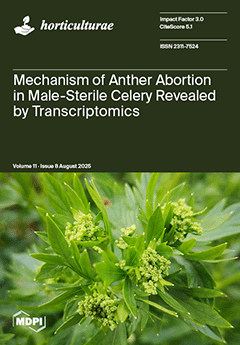Despite its value as a culinary, medicinal, and essential oil crop, caraway struggles to grow and develop its biochemical quality in drought-prone sandy soils. To tackle this challenge, we conducted two field trials under drip irrigation, testing four rates of organic manure (0, 5, 10, and 15 ton/hectare (ha) and three foliar biostimulants: vitamin B
1 (50 and 100 mg L
−1), vitamin E (50 and 100 mg L
−1), and active yeast (100 and 150 mL L
−1). We used a randomized split-plot design with three replicates, assigning manure rates to main plots and biostimulants to subplots. We measured plant height, stem diameter, branch number, dry biomass, umbels per plant, 1000-seed weight, seed yield (per plant and per ha), essential oil content, chlorophyll a and b, carotenoids, and leaf N, P, and K. All treatments outperformed the unfertilized control. Applying 15 ton/ha of manure alone increased mean plant height by 185.3 cm, stem diameter by 2.93 mm, branch number by 14.5, and herbal weight by 91.97 g across both seasons—a gain of about 11–15%. Foliar application of vitamin B
1 at 100 mg L
−1 (without manure) achieved even larger gains: mean plant height improved by 176.5 cm, stem diameter by 2.6 mm, branches number by 15.1, and herbal biomass by 103.95 g (20–36% growth increases). It also boosted essential oil yield by 1.89 mL per plant (16–50%) and enhanced nutrient uptake. The most pronounced synergy emerged when combining 15 ton/ha of manure with 100 mg L
−1 vitamin B
1, raising seed yield to 1698.8 kg/ha (35%), plant height to 184.7 cm (52%), number of branches to 17.4 per plant (56%), umbels to 38.1 per plant (42%), 1000-seed weight to 16.9 g (48%), and essential oil yield to 2.3 mL per plant (115%), compared to the control. Chlorophyll a increased by 50%, chlorophyll b by 33%, carotenoids by 35%, and leaf N, P, and K by 43%, 90%, and 76%, respectively. Manure combined with vitamin E or yeast delivered moderate improvements. These findings demonstrate that integrating organic manure with targeted foliar biostimulants—especially vitamin B
1—under drip irrigation, is a sustainable strategy to maximize caraway yield, oil content, and nutritional quality on marginal sandy soils.
Full article





